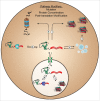Manipulating the aggregation activity of human prion-like proteins
- PMID: 28934062
- PMCID: PMC5639851
- DOI: 10.1080/19336896.2017.1356560
Manipulating the aggregation activity of human prion-like proteins
Abstract
Considerable advances in understanding the protein features favoring prion formation in yeast have facilitated the development of effective yeast prion prediction algorithms. Here we discuss a recent study in which we systematically explored the utility of the yeast prion prediction algorithm PAPA for designing mutations to modulate the aggregation activity of the human prion-like protein hnRNPA2B1. Mutations in hnRNPA2B1 cause multisystem proteinopathy in humans, and accelerate aggregation of the protein in vitro. Additionally, mutant hnRNPA2B1 forms cytoplasmic inclusions when expressed in Drosophila, and the mutant prion-like domain can substitute for a portion of a yeast prion domain in supporting prion activity in yeast. PAPA was quite successful at predicting the effects of PrLD mutations on prion activity in yeast and on in vitro aggregation propensity. Additionally, PAPA successfully predicted the effects of most, but not all, mutations in the PrLD of the hnRNPA2B1 protein when expressed in Drosophila. These results suggest that PAPA is quite effective at predicting the effects of mutations on intrinsic aggregation propensity, but that intracellular factors can influence aggregation and prion-like activity in vivo. A more complete understanding of these intracellular factors may inform the next generation of prion prediction algorithms.
Keywords: amyloid; prion; prion-like domains; protein aggregation; yeast.
Figures

Comment on
- Extra View to: Paul KR, Molliex A, Cascarina S, Boncella AE, Taylor JP, Ross ED. Effects of mutations on the aggregation propensity of the human prion-like protein hnRNPA2B1. Mol Cell Biol. 2017; 37:e00652-16. doi:10.1128/MCB.00652-16. PMID:28137911.
Similar articles
-
Effects of Mutations on the Aggregation Propensity of the Human Prion-Like Protein hnRNPA2B1.Mol Cell Biol. 2017 Mar 31;37(8):e00652-16. doi: 10.1128/MCB.00652-16. Print 2017 Apr 15. Mol Cell Biol. 2017. PMID: 28137911 Free PMC article.
-
Mutations in prion-like domains in hnRNPA2B1 and hnRNPA1 cause multisystem proteinopathy and ALS.Nature. 2013 Mar 28;495(7442):467-73. doi: 10.1038/nature11922. Epub 2013 Mar 3. Nature. 2013. PMID: 23455423 Free PMC article.
-
Perfecting prediction of mutational impact on the aggregation propensity of the ALS-associated hnRNPA2 prion-like protein.FEBS Lett. 2017 Jul;591(13):1966-1971. doi: 10.1002/1873-3468.12698. Epub 2017 Jun 18. FEBS Lett. 2017. PMID: 28542905
-
Prion-like domains as epigenetic regulators, scaffolds for subcellular organization, and drivers of neurodegenerative disease.Brain Res. 2016 Sep 15;1647:9-18. doi: 10.1016/j.brainres.2016.02.037. Epub 2016 Mar 18. Brain Res. 2016. PMID: 26996412 Free PMC article. Review.
-
Aggregation and degradation scales for prion-like domains: sequence features and context weigh in.Curr Genet. 2019 Apr;65(2):387-392. doi: 10.1007/s00294-018-0890-0. Epub 2018 Oct 11. Curr Genet. 2019. PMID: 30310993 Review.
Cited by
-
Natural and pathogenic protein sequence variation affecting prion-like domains within and across human proteomes.BMC Genomics. 2020 Jan 8;21(1):23. doi: 10.1186/s12864-019-6425-3. BMC Genomics. 2020. PMID: 31914925 Free PMC article.
-
N-terminal region of Drosophila melanogaster Argonaute2 forms amyloid-like aggregates.BMC Biol. 2023 Apr 19;21(1):78. doi: 10.1186/s12915-023-01569-3. BMC Biol. 2023. PMID: 37072852 Free PMC article.
-
Exogenous prion-like proteins and their potential to trigger cognitive dysfunction.Mol Syst Biol. 2025 Aug;21(8):1004-1029. doi: 10.1038/s44320-025-00114-4. Epub 2025 May 27. Mol Syst Biol. 2025. PMID: 40425815 Free PMC article.
-
Conservation of Prion-Like Composition and Sequence in Prion-Formers and Prion-Like Proteins of Saccharomyces cerevisiae.Front Mol Biosci. 2019 Jul 11;6:54. doi: 10.3389/fmolb.2019.00054. eCollection 2019. Front Mol Biosci. 2019. PMID: 31355208 Free PMC article.
-
Prevalence and species distribution of the low-complexity, amyloid-like, reversible, kinked segment structural motif in amyloid-like fibrils.J Biol Chem. 2021 Oct;297(4):101194. doi: 10.1016/j.jbc.2021.101194. Epub 2021 Sep 16. J Biol Chem. 2021. PMID: 34537246 Free PMC article.
References
MeSH terms
Substances
Grants and funding
LinkOut - more resources
Full Text Sources
Other Literature Sources
Molecular Biology Databases
Miscellaneous
